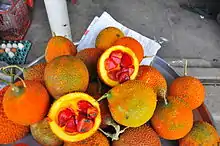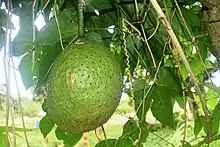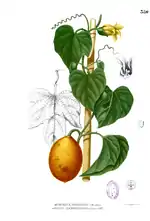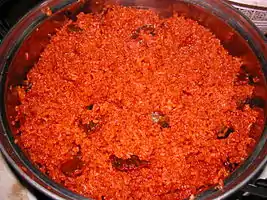Gac
Gấc [IPA ɣək̚˧˦] (Momordica cochinchinensis) is a type of perennial melon grown throughout Southeast Asian countries and Northeastern Australia. Gấc is notable for its vivid orange-reddish color resulting from its rich content of beta-carotene and lycopene.
| Gấc | |
|---|---|
 | |
| Exterior and cross-sectional interior of gac | |
| Scientific classification | |
| Kingdom: | Plantae |
| Clade: | Tracheophytes |
| Clade: | Angiosperms |
| Clade: | Eudicots |
| Clade: | Rosids |
| Order: | Cucurbitales |
| Family: | Cucurbitaceae |
| Genus: | Momordica |
| Species: | M. cochinchinensis |
| Binomial name | |
| Momordica cochinchinensis | |
Etymology
As gấc originated in Vietnam, it is commonly called by its Vietnamese name (gấc, pronounced [ɣək˦˥]). The fruit may also be called trái gấc or quả gấc as trái or quả means 'fruit' in Vietnamese. Additional English common names include giant spine gourd and sweet gourd.[1]
The species name cochinchinensis derives from the Cochinchina region in the southern part of Vietnam, although it is grown and consumed in many parts of the world.[2]
History
Sprengel found that the plant belonged to the Linnean genus Momordica and changed its name in 1826.[3]
Characteristics
Gấc grows as dioecious vines, meaning its male and female flowers are on separate plants, producing flowers typically 5–10 centimetres (2–4 in) in length. Its vines can extend to 20 metres (70 ft) long, and its flowers blooms once a year, single or in bundle, around two to three months after the vines are planted. In one season, a plant can produce from 30 to 60 fruits.[4]
Fruit


Typically, gấc fruits are round or oblong, about 13 centimetres (5 in) in length and 10 centimetres (4 in) in diameter, covered with small spines on the exocarp. Upon ripening, gấc gradually changes colors, from green to yellow, orange and finally red when it can be harvested. At this time, the fruit is hard, but turns soft quickly, creating a challenge for storage and transportation.[4]
Gấc fruit has a mild taste and dense flesh (mesocarp). The inside of a gấc fruit comprises two parts: fruit (yellow) and seed membrane (red color). Larger fruits have a higher percentage of edible aril than smaller fruits.[5]
Breeding and cultivation
As gac plant is dioecious, both male and female plants are needed; hence, farmers must have at least one corresponding male plant growing in or around the gardens for the fruit-bearing female plants to be pollinated. When grown from seed, the ratio of male to female plants is unpredictable.[5]
Pollination may be facilitated by insects, but hand pollination allows for better fruit yield. An alternative method is to graft female material onto the main shoot of a male plant.[6]
For maximum insect-aided pollination, the recommended ratio is about 1 male for every 10 female plants.[5] If propagating from vines, farmers make diagonal cut (around 15–20 centimetres (6–8 in) long and 3–6 millimetres (0.1–0.2 in) wide), then root the tubers in water or well-aerated, moist potting media before planting.[5]
Apart from Southeast Asian countries where the fruits are native, gac can be grown in sub-tropical climate regions.[1] Cool temperatures inhibit growth.[5]
Uses

Gấc has been commonly used in its native countries, mainly as food and traditional medicine. Its use as a folk medicine dates back over centuries in China and Vietnam.[7] Gấc seeds, known as mù biē zǐ (meaning 'wooden turtle seed'), are used for a variety of internal and topical purposes in traditional medicine.[8]
The aril surrounding gấc seeds when the fruits are ripe is cooked with sticky rice to make xôi gấc, a traditional Vietnamese dish in red color served at weddings and New Year celebrations. In addition, the immature green fruit is also used as a vegetable in India.[9] The spiny skin is removed and the fruits are sliced and cooked sometimes with potato or bottle gourd. In Sri Lanka, gấc is used in curry, and in Thailand, gấc is served with ice cream.[10]
Due to the high contents of beta-carotene and lycopene, extracts from the fruit's arils are used to manufacture dietary supplements in soft capsules or are sometimes mixed into beverages.[11]
Composition
Gac fruit, seeds, and seed oil contain substantial amounts of beta-carotene and lycopene which collectively impart the characteristic red-orange color to the fruit's tissues.[12][13][14][15] Both aril and seeds are rich in monounsaturated and polyunsaturated fatty acids,[16] with oil containing 69% unsaturated fats, including 35% as polyunsaturated fats.[15] Gac has a high concentration of linoleic acid (omega-6) and omega-3 fatty acids.[16]
References
- "Taxon: Momordica cochinchinensis (Lour.) Spreng. U.S. National Plant Germplasm System". Retrieved 2018-11-26.
- Vuong, Le Thuy; Franke, Adrian A.; Custer, Laurie J.; Murphy, Suzanne P. (2006-09-01). "Momordica cochinchinensis Spreng. (gac) fruit carotenoids reevaluated". Journal of Food Composition and Analysis. 19 (6–7): 664–668. doi:10.1016/j.jfca.2005.02.001. ISSN 0889-1575.
- Vuong, Le (2000). "Underutilized β-Carotene–Rich Crops of Vietnam". Food and Nutrition Bulletin. 21 (2): 173–181. doi:10.1177/156482650002100211.
- Osman, Mohamad; Sulaiman, Zulkefly; Saleh, Ghizan; et al. (2017). "Gac fruit, a plant genetic resource with high potential". Transactions of Persatuan Genetik Malaysia. 7.
- Parks, Sophie; Murray, Carly; Gale, David; et al. (2013). "Propagation and production of gac (Momordica cochinchinensis Spreng.), A greenhouse case study". Experimental Agriculture. 49 (2): 234–243. doi:10.1017/S0014479712001081. S2CID 86531219.
- "Propagation and cultivation of Gac plant". Gac Research
University of Newcastle, Australia. Retrieved 2018-11-26. - "Researchers use nature to fight cancer". James Cook University. Retrieved 2018-11-26.
- Chuyen, Hoang; Nguyen, Minh; Roach, Paul; et al. (Spring 2015). "Gac fruit (Momordica cochinchinensis Soreng,): a rich source of bioactive compounds and its potential health benefits". Food Science and Technology. 50 (3): 567–577. doi:10.1111/ijfs.12721.
- Tran, Xuan T.; Parks, Sophie E.; Roach, Paul D.; et al. (2015-10-06). "Effects of maturity on physicochemical properties of Gac fruit (Momordica cochinchinensis Spreng.)". Food Science & Nutrition. 4 (2): 305–314. doi:10.1002/fsn3.291. ISSN 2048-7177. PMC 4779482. PMID 27004120.
- "RMIT researcher uncovers the exceptional health benefits of gấc fruit". RMIT University Vietnam. Retrieved 2018-11-26.
- Goodman, Lawrence (August 2015). "The Next Big Fruit Juice?". Brown Alumni Magazine. Retrieved 12 August 2017.
- Mai, H. C.; Truong, V; Debaste, F (2014). "Carotenoids concentration of gac (Momordica cochinchinensis Spreng.) fruit oil using cross-flow filtration technology". Journal of Food Science. 79 (11): E2222–31. doi:10.1111/1750-3841.12661. PMID 25367308.
- Maoka, T; Yamano, Y; Wada, A; et al. (2015). "Oxidative metabolites of lycopene and γ-carotene in gac (Momordica cochinchinensis)". Journal of Agricultural and Food Chemistry. 63 (5): 1622–30. doi:10.1021/jf505008d. PMID 25633727.
- Wimalasiri, Dilani; Brkljača, Robert; Piva, Terrence J.; et al. (2017). "Comparative analysis of carotenoid content in Momordica cochinchinensis (Cucurbitaceae) collected from Australia, Thailand and Vietnam". Journal of Food Science and Technology. 54 (9): 2814–2824. doi:10.1007/s13197-017-2719-0. ISSN 0022-1155. PMC 5583111. PMID 28928521.
- Vuong, LT; King, JC (June 2003). "A method of preserving and testing the acceptability of gac fruit oil, a good source of beta-carotene and essential fatty acids". Food and Nutrition Bulletin. 24 (2): 224–230. doi:10.1177/156482650302400209. ISSN 0379-5721. PMID 12891827.
- Ishida, Betty; Turner, Charlotta; Chapman, Mary; A McKeon, Thomas (2004). "Fatty acid and carotenoid composition of gac (Momordica cochinchinensis Spreng) fruit". Journal of Agricultural and Food Chemistry. 52 (2): 274–9. doi:10.1021/jf030616i. PMID 14733508.
External links
 Media related to Momordica cochinchinensis at Wikimedia Commons
Media related to Momordica cochinchinensis at Wikimedia Commons